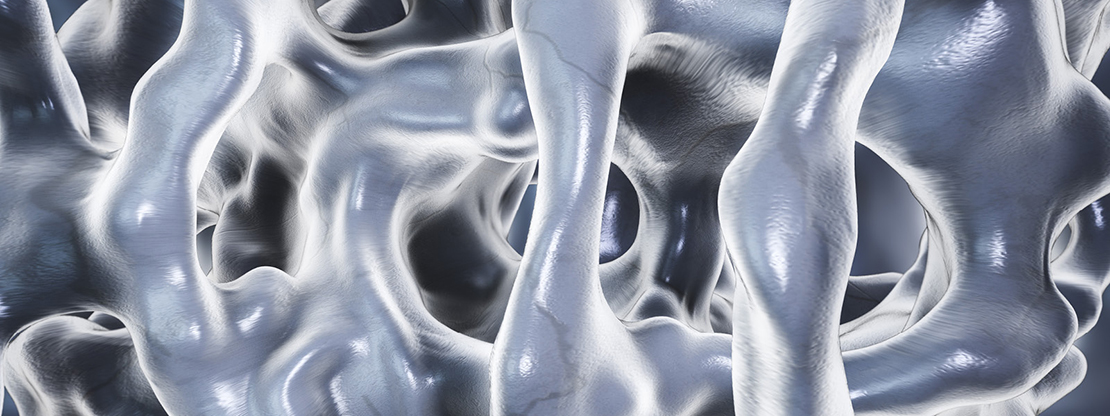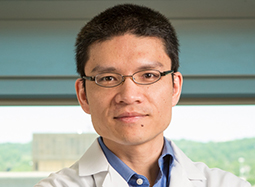Meet the scientist behind the science: Dr. Tao Yang
May 16, 2018

More than 30 million people in the U.S. have osteoarthritis, a degenerative joint disease caused by the breakdown of cartilage, a shock-absorber-like tissue between the bones. Treatment options are limited and, with an aging global population, scientists are working hard to find improved ways to manage this painful and often debilitating disease.
One of these scientists is Van Andel Research Institute’s Dr. Tao Yang, whose work aims to reveal the underlying causes of osteoarthritis, as well as other bone diseases such as osteoporosis. Yang earned his Ph.D. in biochemistry from Shanghai Institute of Biochemistry and Cell Biology at the Chinese Academy of Sciences and completed a postdoctoral fellowship at Baylor College of Medicine before joining VARI in 2013. In 2017, he was awarded a grant from the Arthritis National Research Foundation and, in 2018, he was named ANRF’s Frances D. Morongo Memorial Fellow.
VAI Voice chatted with Dr. Yang about his work, what inspired him to study skeletal diseases, and where he sees osteoarthritis research and treatment going in the future.
Where did you grow up?
Liuzhou, which is a southern city in China.
When did you first become interested in science? What inspired you to study bone diseases?
My interest in science was influenced by my father, who was a mechanical engineer and liked to talk about science. He had quite a few books about science and technology, so I had a chance to read them during my childhood.
I also love animals and had pets from elementary to high school, including turtles, rabbits and different kinds of birds such as parrots and hawks. I was amazed by their beauty and uniqueness, and so that also triggered my strong interest in biology. I appreciate my parents for being quite tolerant of this hobby, as having many pets in a high-rise building is not an easy thing.

I chose biochemistry as a major in college, but at the time I did not have a clear plan to become a scientist or professor; the choice was more rooted in my curiosity about how life works at the molecular level. As I was finishing my Ph.D. thesis, I became interested in studying developmental biology and genetics using models. This helped me decide where to do my postdoctoral fellowship.
My specific interest in bone diseases was partly inspired by my grandfather’s osteoarthritis. He was an avid sports lover, but as his osteoarthritis worsened he had to quit most of his exercises, which ultimately impacted his health. This left a strong impression on me — bone diseases are not only a problem in bone, but a problem that has a major effect on overall health and wellbeing.
What do you study?
People have varying susceptibility to certain diseases, and one particularly strong determinant of disease risk is a person’s genetics. Identifying genes that play a role in disease and developing a thorough understanding how they work gives us targets for developing new medicines.
Specifically, my lab is interested in the genetic factors that cause bone and joint disorders. We have identified some genes that may be related to osteoporosis and osteoarthritis and are now focusing on understanding how they work and how they can be targeted for bone and joint disease treatment.
What do you see on the horizon for osteoarthritis and bone diseases in general?
Musculoskeletal diseases are among the most common medical conditions worldwide and are a severe burden for people with the disease. Unfortunately, osteoarthritis is not curable at the moment due to the nature of the cartilage and the lack of clarity about the disease’s underlying mechanisms. But these challenges are also opportunities. In my view, there are several things can greatly impact the field of skeletal disease research.
The first is using new, cutting-edge genetic and epigenetic screening techniques to uncover the primary causes of the disease. We can then use laboratory models to investigate possible new therapies. A new tool invented in recent years called CRISPR/Cas has exponentially enhanced our ability in generate such laboratory disease models.
Secondly, a better understanding of age and its impact on disease risk is critical because aging is one of the greatest risk factors for many bone diseases. Some pioneering studies have shown promising evidence that delaying aging may have treatment applications for age-related diseases. This area of research is booming and could greatly impact skeletal disease research.
Lastly, recent advancements in skeletal stem cell research provide new avenues to explore regenerating damaged skeletal tissue, such as joint cartilage.
To date, what has been your favorite accomplishment?
So far, my favorite accomplishment is the graduation of the first Ph.D. student from my lab. I am very proud of the progress in his scientific skills and his great transformation during the years in my lab. It was very rewarding and a remarkable milestone in my life.
When you’re not doing research, what do you like to do in your free time?
A big part of my free time is spent reading. Also, I very much enjoy hiking in local parks and the trails around the area with my family and dog. The woods and water of Michigan are truly amazing. As a member of Grand Rapids Badminton Club, I play this sport almost every weekend with friends. I also like photography and have been shooting for more than 15 years.
How do donors and philanthropy impact your research?
Philanthropy has had a big impact in my research. My postdoctoral work was supported by two philanthropic awards: one from the Arthritis Foundation and the Rolanette and Berdon Lawrence Research Award. My current work is supported by Arthritis National Research Foundation (ANRF), the Institute’s Employee Impact Campaign, and the Institute’s Faculty Innovation Award, all philanthropy-based funds. Their support allows me to publish findings that form the basis of our major research areas, and the data generated from these projects will greatly enhance my opportunity to obtain federal funding in the future. I am very grateful for these philanthropic funds, which have tremendously helped me as a relatively new principal investigator to smoothly develop my scientific program in skeletal disease research.
Learn more about Dr. Yang and his research here. Throughout the year, we’ll be highlighting the Institute’s scientists, giving you a sneak peek at the people behind the science. Read them all here.
